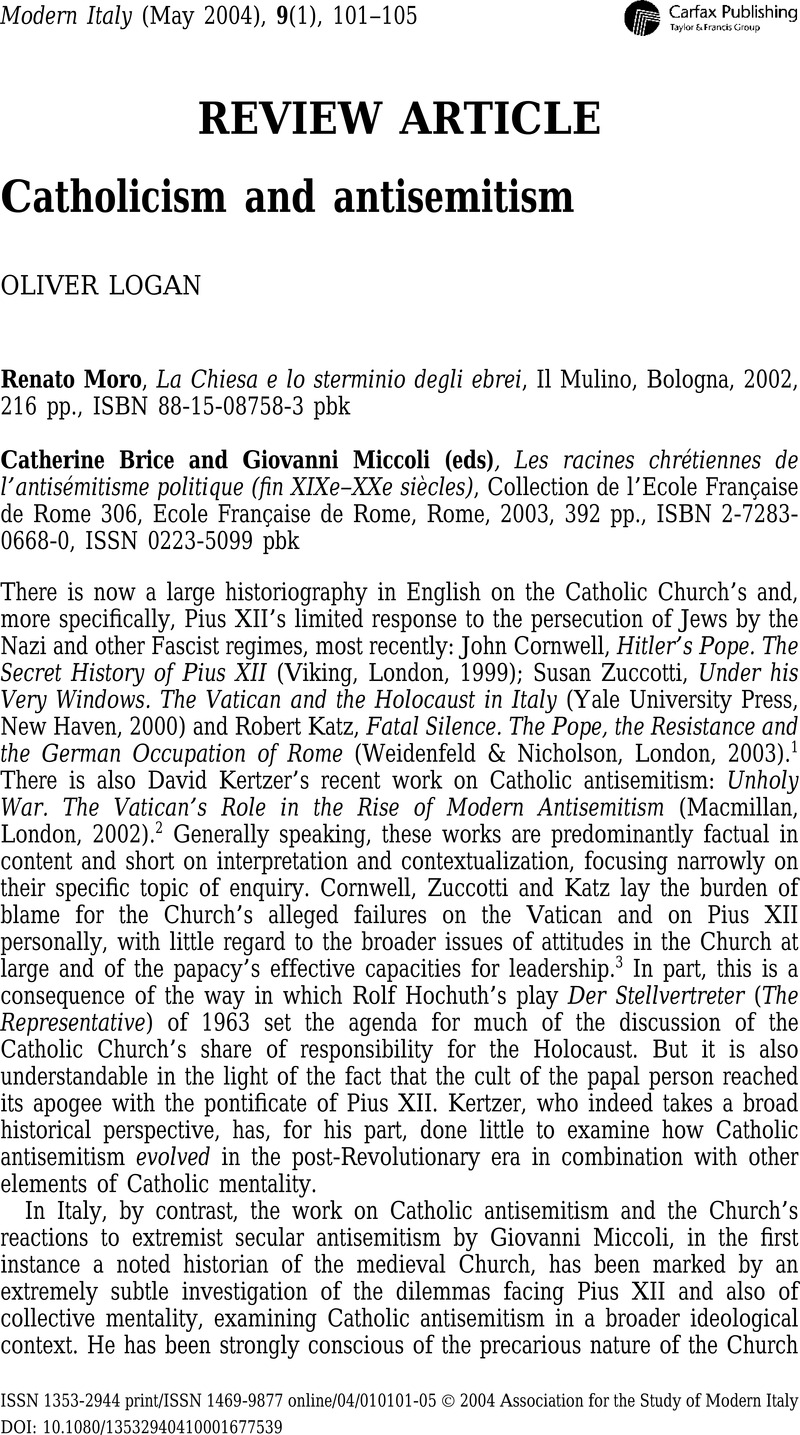No CrossRef data available.
Published online by Cambridge University Press: 07 January 2016

1. Note also the depressingly confrontational ‘Symposium on Pope Pius XII and the Holocaust in Italy’, Journal of Modern Italian Studies , 7, 2, 2002, pp. 215–268 and the highly polemical Daniel Joseph Goldhagen, A Moral Reckoning. The Role of the Catholic Church in the Holocaust and its Unfulfilled Duty of Repair, Alfred Knopf, New York and Little Brown, London, 2002.Google Scholar
2. US edn, The Pope against the Jews , Knopf, New York, 2001.Google Scholar
3. Perhaps the best-known contribution to the debate defending the Catholic position is Pierre Blet, SJ, Pie XII et la Seconde Guerre mondiale , Perrin, Paris, 1997 (English edn, Pius XII and the Second World War, According to the Archives of the Vatican , trans. by Johnson, Lawrence L., Gracewing, , Hereford, , 1999) which, while clearly concerned to combat the ‘black legend’ of Pius XII, was, in any case, inevitably written from a Vaticanological perspective: Blet was one of a team of Jesuits engaged in the compilation of Actes et documents du Saint-Siège relatifs à la Seconde Guerre Mondiale , eds Blet, Pierre, Graham, Robert, Martini, Angelo and Schneider, Burckhardt, 12 vols, Libreria Editrice Vaticana, Rome, 1965–82.Google Scholar
4. ‘Santa Sede, questione ebraica e antisemitismo fra Otto e Novecento’, in Storia d'Italia. Annali 11. Gli ebrei in Italia , ed. Vivanti, Corrado, 2, Dall'emancipazione a oggi , Einaudi, Turin, 1997, pp. 1368–1754; and ‘La Santa Sede nella II guerra mondiale: il problema dei “silenzi” di Pio XII’, in Fra mito della cristianità e secolarizzazione, Marietti, Turin, 1975, pp. 131–337, the convoluted arguments of which are re-worked in more approachable form in I dilemmi e I silenzi di Pio XII. Vaticano, Seconda guerra mondiale e Shoah, Rizzoli, Milan, 2000.Google Scholar
5. In La formazione della classe dirigente cattolica (1929–1937) , Il Mulino, Bologna, 1979.Google Scholar
6. Notably, ‘Le premesse dell'atteggiamento cattolico di fronte alla legislazione razziale fascista. Cattolici ed ebrei nell'Italia degli anni venti (1919–1932)’, Storia Contempoanea , 19, 6, 1988, pp. 1013–1119.Google Scholar
7. ‘Il “modernismo buono”. La “modernizzazione” cattolica tra fascismo e postfascismo come problema storiografica’, Storia Contemporanea , 19, 4, 1988, pp. 497–511.Google Scholar
8. In La segregazione amichevole. ‘La Civiltà Cattolica’ e la questione ebraica , Riuniti, Rome, 2000.Google Scholar
9. ‘Santa Sede, questione ebraica e antisemitismo’.Google Scholar
10. Cf. Anderson, Benedict, Imagined Communities. Reflections on the Origins and Spread of Nationalism , Verso, London, 1983.Google Scholar
11. Gentile, Emilio, ‘The Struggle for Modernity: Echoes of the Dreyfus Affair in Italian Political Culture’, Journal of Contemporary History , 33, 4, 1998, pp. 497–511, p. 500.CrossRefGoogle Scholar
12. In ‘The image of the Jew in the Folklore and Literature of the Postrisorgimento’, Journal of European Studies , 9, 1979, pp. 261–72.Google Scholar
13. In The Roots of Hate. Anti-Semitism in Europe before the Holocaust , Cambridge University Press, Cambridge, 2003, p. 45.Google Scholar